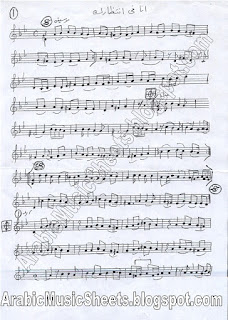" Ana Fe Entezarak " Song Sheet
Words : Mahmoud Perm Eltonsy
Composer: Zakaria Ahmed
Sing: Umm Kulthum
production: 1943
It's scale " Hejaz " ( Re ) = g minor Harmonic
( http://en.wikipedia.org/wiki/Umm_Kulthum )
Golden age
Umm Kulthum's musical directions in the 1940s and early 1950s and her mature performing style led this period to becoming popularly known as "the golden age" of Umm Kulthum. In keeping with changing popular taste as well as her own artistic inclinations, in the early 1940s, she requested songs from composer Zakariya Ahmad and colloquial poet Mahmud Bayram el-Tunsi cast in styles considered to be indigenously Egyptian. This represented a dramatic departure from the modernist romantic songs of the 1930s, mainly led by Mohammad El-Qasabgi. Umm Kulthum had abstained from singing Qasabgi's music since the early 1940s. Their last stage song collaboration in 1941 was "Raq el Habib" ("The Lover's Heart Softens"), one of her most popular, intricate, and high-caliber songs.The reason for the separation is not clear. It is speculated that this was due in part to the popular failure of the movie Aida, in which Umm Kulthum sings mostly Qasabgi's compositions, including the first part of the opera.
Qasabgi was experimenting with Arabic music, under the influence of classical European music, and was composing a lot for Asmahan, a singer who immigrated to Egypt from Lebanon and was the only serious competitor for Umm Kulthum before Asmahan's death in a car accident in 1944.
Simultaneously, Umm Kulthum started to rely heavily on a younger composer who joined her artistic team a few years earlier: Riad El-Sombati. While Sombati was evidently influenced by Qasabgi in those early years, the melodic lines he composed were more lyrical and more acceptable to Umm Kulthum's audience. The result of collaborations with Rami/Sombati and al-Tunisi/Ahmad was a populist and popular repertoire that had lasting appeal for the Egyptian audience.
In 1946, Umm Kulthum defied all odds by presenting a religious poem in classical Arabic during one of her monthly concerts, "Salou Qalbi" ("Ask My Heart"), written by Ahmad Shawqi and composed by Sombati. The success was immediate. It reconnected Umm Kulthum with her early singing years, defined Sombati's unique style in composing and established him as the best composer of music for poems in classical Arabic, toppling Mohammed Abdel Wahab. Similar poems written by Shawqi were subsequently composed by Sombati and sung by Umm Kulthum, including "Woulida el Houda" ("The Prophet is Born"; 1949), in which she raised eyebrows of royalists by singing a verse that describes the Prophet Mohammad as "the Imam of Socialists".
At the peak of her career, in 1950, Umm Kulthum sang Sombati's composition of excerpts of what Ahmad Rami considered the accomplishment of his career: the translation into classical Arabic of Omar Khayyám's quartets (Rubayyiat el Khayyam). The song included quartets that dealt with both epicurism and redemption. Ibrahim Nagi's poem "Al-Atlal" ("The Ruins"), composed by Sonbati and premiered in 1966, is considered by many as Umm Kulthum's best song. While this is debatable, as Umm Kulthum's vocal abilities had regressed considerably by then, the song can be viewed as the last example of genuine Arabic music at a time when even Umm Kulthum had started to compromise by singing Western-influenced pieces composed by her old rival Mohammed Abdel Wahab.
The duration of Umm Kulthum's songs in performance was not fixed, but varied based on the level of emotive interaction between the singer and her audience and Umm Kulthum's own mood for creativity.
An improvisatory technique, which was typical of old classical Arabic singing, and which she executed for as long as she could have (both her regressing vocal abilities with age and the increased Westernization of Arabic music became an impediment to this art), was to repeat a single line or stance over and over, subtly altering the emotive emphasis and intensity and exploring one or various musical modal scales (maqām) each time to bring her audiences into a euphoric and ecstatic state known in Arabic as "tarab" طرب. For example, the available live performances (about 30) of Ya Zalemni, one of her most popular songs, varied in length from 45 to 90 minutes, depending on both her creative mood for improvisations and the audience request for more repetitions, illustrating the dynamic relationship between the singer and the audience as they fed off each other's emotional energy.
The spontaneous creativity of Umm Kulthum as a singer is most impressive when, upon listening to these many different renditions of the same song over a time span of five years (1954–1959), the listener is offered a totally unique and different experience. This intense, highly personalized relationship was undoubtedly one of the reasons for Umm Kulthum's tremendous success as an artist. Worth noting though that the length of a performance did not necessarily reflect either its quality or the improvisatory creativity of Umm Kulthum. Some of her best performances were 25–45 minutes in duration, such as the three available renditions, including the commercial version of El Awwila Fi'l Gharam ("First in Love"), and Ana Fi Intizarak ("I am waiting for you"), (commercial and 3-3-1955 performance). On the other hand, her songs as of the mid-1960s would extend sometimes over a duration of two hours (premiere of Enta Omri, Enta el Hobb, etc.); however, the repetitions, mostly executed upon the request of the audience, were often devoid of creative musical improvisations and limited to vocal colorful variations on a syllable, letter or word.
Around 1965, Umm Kulthum started cooperating with composer Mohammed Abdel Wahab. Her first song composed by Abdel Wahab, "Enta Omri" (You are my Life"), was considered the "summit meeting". Several beautiful songs composed by Abdel Wahab followed, such as "Amal Hayati" ("The Hope of my Life"), "Fakkarouni" ("They reminded Me"), and others.
Umm Kulthum also sang for composers Mohammad El Mougi and Sayyed Mikkawi.







